Educating the world about pink birds
The flamingos and other animals in the living collection at WWT centres are not just housed to look beautiful and be interesting for visitors to see. They play a vitally important role in education and engagement, providing a valuable link to the natural world and a connection with nature that may be hard for many people to achieve for these species out in the wild. WWT centres host many thousands of children and young people on educational visits each year. From toddlers and nursery age children, through primary and secondary pupils, sixth form and college groups, to university degree students and beyond, WWT living collections cement important knowledge about biology, ecology, conservation and environmental science. In this flamingo diary, we will look at what makes the flamingos, and other WWT living collection animals really good for education and engagement.
Let's think about what we do with our flamingos, e.g. how they are cared for and what information we collect on them, that makes for good educational activities. For teachers thinking about ways to craft a field trip to WWT or for interested visitors who want to understand more about the flamingos on their next visit, follow my examples for "flamingo education" below!
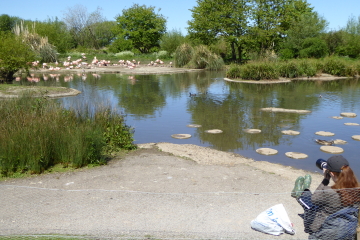
Educating the next generation. A student collecting data on the WWT Slimbridge Chilean flamingos (photo above).
We know who our animals are
The flamingos, for example, all wear plastic leg rings so that living collection staff can tell each bird apart. Just the same as the the wild Bewick’s swans are individually identifiable by their bill patterns, and therefore each bird’s life can be mapped out and swan's story told, so the leg rings put on the flamingos in the collection all us to do the same. These data can mean we can manage our flamingo flocks according to the needs of the individual birds and find out how changes to their care are responded to by watching the behaviour of specific flamingos. We've been mapping "flamingo friends" for over ten years now, and we get students involved by teaching them about flamingo social behaviour or by working with them on site as researchers so they can collect such data themselves.

Examples of flamingo social networks- an image of the connections between each bird in the flock. The birds are the dots or squares (with their ring codes as labels) and the lines are the relationships between them (photo above).
What you can see
- Look out for the leg rings on the flamingos on your next visit, you will see they are all different codes.
- Spot different flamingo rings and see who-is-who in a flock.
- Look for different personalities and behaviours in the flocks as you watch them.
Records of what we do
We keep various records of the flamingos that we care for. For example, we keep individual data on the age and sex of the birds, how long they have been at WWT, where they have come from, and who their parents are. We also keep data on the bird’s mass if they have been weighed, as well as other health information such as their body and feather condition. Records of egg development over the course of a flamingo’s 30 day incubation periods are really important for how we breed our birds. Understanding how the egg changes in mass and how to regulate temperature and humidity are essential for ensuring a chick hatches successfully. Records also allow us to trace where birds go between WWT centres and information on the age structure of a flock (how many individuals of either sex are in what age category) means we can manage groups that will be sustainable. We can share our records with students that are learning how to work with zoo animal populations to show how reliable and complete record keeping is essential to animal health and welfare.
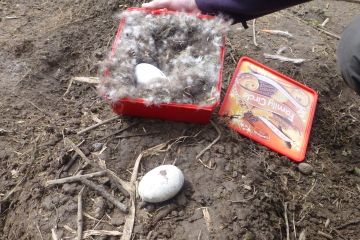
Recording nest and egg locations is essential data to help with flamingo breeding (photo above).
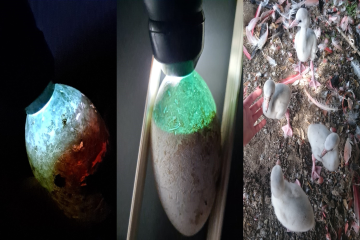
Recording eggs development over time, how much mass is gained/lost and the size of the air space (top of the egg) allows us to produce healthy flamingo chicks (photo above).

Example of "flamingo friends" data (bird rings listed on the left hand side and the top row) that how much time flamingos spend together (1= all the time, 0= never seen together), photo above.
What you can see
Whilst animal records are probably not going to be on show to visitors to the collection at a WWT centre, you can see products of the use of records. Look out for these examples:
- The leg rings on the flamingos, as mentioned above, match the bird to its records.
- Look out for the signage available at animal enclosures, this provides information about the species we keep and, sometimes, signage explains how they are managed and cared for.
- If you see a member of the WWT living collections staff doing their rounds for animal care, they will be collecting data for animal records that will be stored safely away.
- Look out for conservation and research scientists working in the living collection. Again, they will be collecting data on the animals to continually improve animal care. An example of this would be the “nocturnal flamingos” sign that advertises WWT’s award winning night-time flamingo research on the Andean Flamingo House at WWT Slimbridge.
Measuring animal behaviour
Observations of the flamingos helps us calculate how much time they spend on different activities. The important behaviours for a flamingo to perform are feeding and foraging, preening, resting, socialising and courtship or nesting. We check the time-activity (how much time per behaviour?) of our flamingos by recording the time spent on these important behaviours in a systematic manner. This method of behavioural recording helps us further understand animal welfare, and it’s not just special to the flamingos, we do this across a range of different species.
We've even looked at the flamingos overnight, to see what they get up to when their keepers go home.
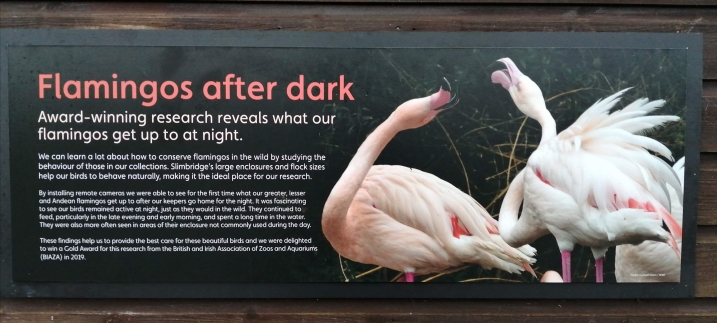
The sign on the WWT Slimbridge Andean Flamingo House that explains the nocturnal flamingo research (photo above).
Our flamingos are excellent tools for education sessions where WWT staff train students in how to recognise and record behaviour. Because the flamingos are obvious to see, and easy to follow, they are a great introduction to how to be an animal behaviour scientist.
What you can see
- Identify how many different types of behaviour you can see a flamingo in a flock performing
- Look and see which behaviours are performed for the longest amount of time, whilst you are watching them
- Where do the birds perform their different behaviours? Are there some areas of their enclosures that they like to use for a specific activity?
- Do the flock all perform the same activity at the same time, or are individuals different?
Where do the flamingos like to be?
Alongside of recording activity patterns, we can also measure how the flamingos use the space provided to them in their enclosure. We can divide up an enclosure into different sections based on the physical features of the enclosure, for example the flamingo’s house, their pool, any islands or nesting areas, and so on. Counting where birds are, or timing how long they stay in each area, tells WWT staff which sections of the enclosure the birds like (and are good for them) and which areas they don’t use (and therefore might need adapting or improving). Methods for evaluating enclosure use in a systematic and structured manner are taught to students that come to WWT on field trips or for workshops to explain why understanding how animals use their space is important to improving animal care.
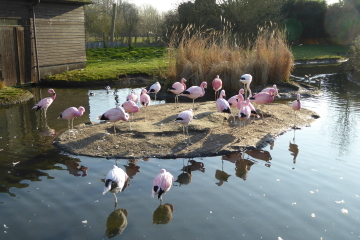
Spot the enclosure usage... where are the flamingos and why are they there? Photo above.
What you can see
- Can you see spot different areas of an enclosure that have been designed for particular species?
- How would you describe the different areas of a flamingo enclosure?
- Look out for where the birds like to be at different times of the day and in different seasons- they will change where the are with season.
Anatomy and physiology, form and function
The whole range of species at WWT means teaching all about anatomy (the different organ systems and structures of the body) and physiology (the reactions and processes inside the body that keep it working) is really engaging. Different species of animals have evolved different characteristics to help them survive in their environments. We can illustrate and help students identify common features and different features that species possess to aid survival in a habitat. For example, flamingos have webbed feet, just like ducks, geese and swans. This shared, common, feature across species is useful to all of them because they all live in and move through wetlands. Flamingos have a very specific bill shape that is different to ducks, geese and swans. This specific feature allows the flamingo to collect food effectively, saving energy and avoiding competition with other animals for the type of food that it likes to eat. We can compare different species at close quarters and allow students the chance of spotting common or specific characteristics of anatomy and physiology so they can learn all about evolution.
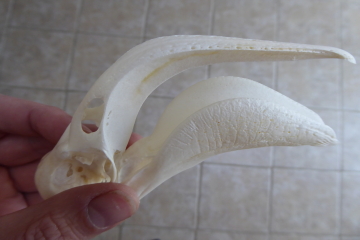
The bill of a lesser flamingo. The unique anatomy of a flamingo's bill means it gains advantages over other species in its habitat (photo above).
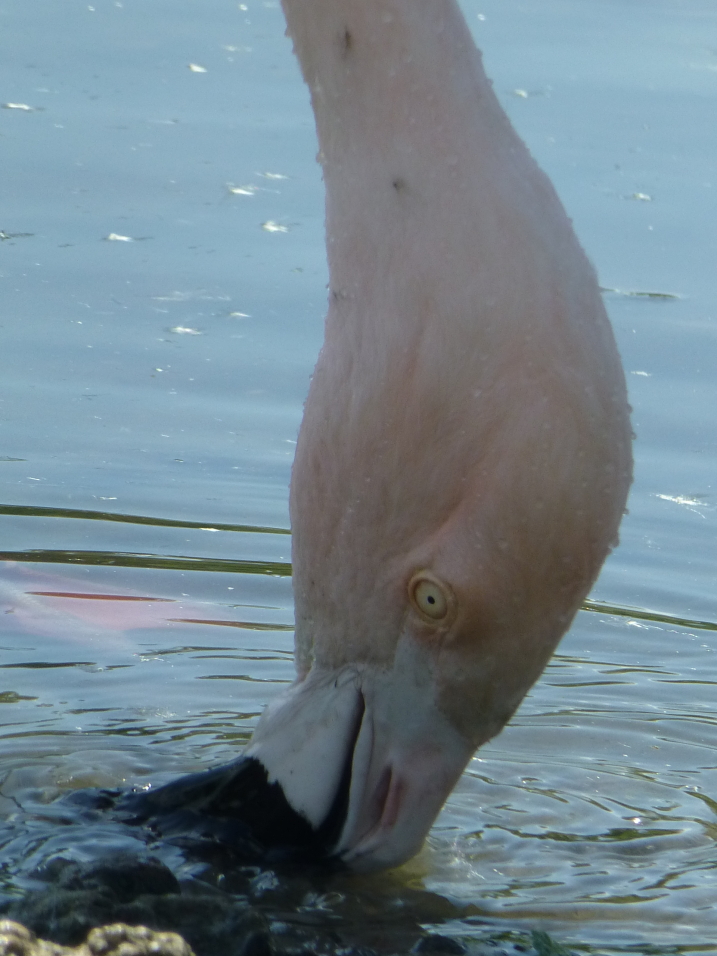
Chilean flamingo filtering. This action can only occur because of the form and function of the flamingo's bill and tongue (photo above).
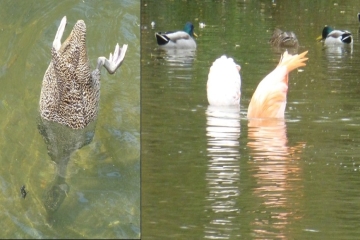
Similar features! Ducks and flamingos can paddle and up-end to find foot. A feature that is helpful across species in the same environment will be possessed by all species (photo above).
What you can see
- Can you spot features on the flamingos that are common to other birds?
- Can you look out for features of the flamingos that make them unique compared to other birds?
- Can you find five features of a bird that make it adapted to a wetland way of life?
- Do you, as a human being, share any common anatomy with any of the animals in the WWT collection?
Conservation biology
All of the species housed in the WWT living collection are important for conservation. Be that as effective ambassadors for telling a story about the wild counterparts of a species, or because we are breeding the species to aid conservation work in other centres like WWT or for reintroduction into the wild. Conservation for the flamingos means breeding them at WWT Slimbridge, Martin Mere, Washington and Llanelli to ensure we have sustainable flocks for the future. It also means researching and studying them so we know what they need to remain healthy under our care. Conservation impact can be measured by seeing how many people are familiar with the flamingo’s story (the threats it faces in the wild, the habitats that need protection, and its long-term future). The flamingos, and other species in the living collection, are the best link between wetland conservation in the real world and why it is important because they represent the species and habitats being conserved. Students can see examples of the individual animals involved in conservation activities and this is really engaging and inspiring.
What you can do
- Look out for the status of a species in the wild by reading the signs at each enclosure. It will tell you how safe or threatened they are.
- Read all about the threats that species face in the wild on the enclosure signs.
- Look out for breeding activities, e.g. flamingos on nests or with chicks.
I hope this has shown that the flamingos are not just there to be pretty in pink, but they are vital tools that WWT staff use for educational purposes, for teaching groups of different ages and educational levels, and for wider engagement with wetland issues. By connecting people with nature through the animals in the collection, we can hopefully inspire much more care about wildlife and wetlands in the future.



